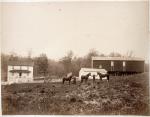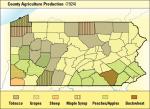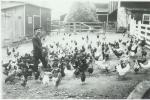Overview: Agriculture and Rural Life
They called it "a farmer's heaven," "the best poor man's country," "the breadbasket of America," and a place where servants could become rich men. Blessed with a mild climate, plentiful rainfall, and rich soils, southeastern Pennsylvania was ideal for farming.
For centuries Native Americans had grown nutritious gardens of corn, squash, beans, and other vegetables. Although the temperatures and weather were more varied than those in Europe, the conditions were similar enough to be very hospitable for most Old World grains, fruits, and livestock.
Drawn by the promise of religious freedom and economic opportunity, Quakers from the British Isles, German Lutherans, pietists, Scots-Irish Presbyterians, and others poured into the colony and pushed deeper and deeper into Indian lands.
From the 1720s until the 1840s, Pennsylvania led the colonies and then the states in the production of food. Sown in immense quantities, wheat quickly became "the grand article of the province." The great wheat fields supported a flourishing flour milling industry along streams that provided the waterpower for gristmills. Pennsylvania farmers grew a huge variety of crops, and created many processed products as well; everything from flax seed to cowhides left Pennsylvania farm gates, much of it for use nearby. Its ties to commercial networks in Philadelphia and Baltimore that linked to markets in Europe and the West Indies made colonial Pennsylvania major exporter of agricultural and forest products to the West Indies, Europe, and markets across the globe.
Land was abundant in Pennsylvania. For more than a century many of its farmers mined the soil, drawing out its nutrients to grow their crops, then cleared more acres to keep up overall production, or moved on to new ground as the yields decreased. Driven onwards by the desire for untilled land, generation after generation of tough, hardscrabble farmers moved the Pennsylvania frontier westward, cutting down millions of acres of primeval forest they replaced with family farms.
The period between 1790 and the 1840 was the golden age of farming in Pennsylvania. The ideal Pennsylvania farm, with its large barns, well-tended fields, and fat livestock, became a symbol of America as a land of independent and prosperous family farmers. In 1820 more than 90 percent of the working population was involved in agriculture. Twenty years later more than 77 percent of the 4.8 million employed persons in Pennsylvania were in agriculture. Agriculture was still the dominant industry in Pennsylvania in the 1860s, but by then a great agricultural revolution was making it harder for Pennsylvania's farms to compete with those in other states.
The average Pennsylvania farm family possessed a range of skills that today's specialists would find astonishing. Farm work demanded enormous physical stamina. Prior to 1840, farmers' simple hand tools had changed little since the times of the ancient Romans. But the industrial revolutions of the nineteenth and twentieth centuries transformed farming from a small family enterprise based on manual labor and folk wisdom into a highly specialized, capital intensive, mechanized, and scientific industry.
Beginning in the 1840s, the nation witnessed the invention and manufacture of a broad range of threshers, harvesters, binders, and other farm machinery that reduced work, increased labor productivity, and, in some cases, increased yields. Small farm equipment manufacturers sprang up across the state to produce the machines used by Pennsylvania farmers.
Using gadgets ranging from hand-cranked apple peelers to dog-powered churns to sharp-pointed grubbing hoes, Pennsylvanians sought to reduce the extreme drudgery of farm work and increase their productivity. The intricate processes of farm labor were undertaken by the family and others in a carefully choreographed ritual. Men and women cooperated closely and often worked together in butchering, haying, making apple butter, and other tasks. Women were generally responsible for buttermaking, poultry management, and raising swine. Their market production was as important as men's, especially in areas that produced butter.
Farm families and neighbors depended on one another to get things done. They "changed works," routinely exchanged services, labor, and goods, employed hired hands who lived with the family, and sometimes loaned a child to work for a neighbor or relative. Farm men and women kept scrupulous records of what they owed each other and every so often they would "settle up" and begin again. But as a rule little cash changed hands, even though work and goods were reckoned in cash value equivalents.
The 1800s also witnessed the shaky beginnings of scientific agriculture. Concerned about soil depletion and the general backwardness of farming in America, gentlemen farmers like John Beale Bordley and Frederick Watts formed organizations for the scientific study of agriculture, built experimental farms upon which they tested the latest theories, and lobbied for state-funded agricultural schools and agencies. "Scientific" agriculture, however, struggled in its infant years. Even the greatest European researchers could not figure out the complex processes of plant physiology, nutrition, soils, and genetics. Gentleman farmers sometimes made valuable contributions, but their expensive experiments were far beyond the reach of ordinary farmers. For quite a long time, most farmers regarded "book farming" with suspicion, if not contempt.
To bring the agricultural products and raw materials of the state's interior to market, the Pennsylvania legislature in the early 1800s helped fund the construction of an ambitious network of roads and canals. In the mid-1800s, railroads revolutionized land transportation and, in the process, transformed American agriculture. Linking previously distant and isolated regions into a national economic system, the railroads enabled regional specialization of agricultural production, the growth of the corn and wheat belts that extended from the Midwest to the Great Plains, the booming fruit and produce industries of California and Florida, and the beef industry of the Great Plains.
Home markets continued to account for most of Pennsylvania farm sales. Unable to compete with the huge volume of crops and meat that flooded eastern markets, Commonwealth farmers adjusted their farming patterns to focus on supplying city dwellers, mining and lumbering communities, and villages with milk, butter, maple sugar, hay, potatoes, truck crops, poultry, eggs, fresh meat, and other products.
The late nineteenth century was an era of agricultural surpluses, wild cycles of economic boom and bust, and hard times for American farmers. Represented by a majority in the state legislature until the 1840s, Pennsylvania farmers lost their political power as the state's booming oil, steel, coal, railroad, and manufacturing industries took control of state government. To protect their interests in Harrisburg, Commonwealth farmers organized Granges and other farm associations that lobbied for better schooling, consumer and farm protection legislation, and a State Department of Agriculture.
In the late nineteenth and twentieth centuries, regionally specialized agricultural industries emerged. Fruit specialists, for example, replaced old farm orchards, while tobacco became an important market crop grown only in a few areas. Raised initially to feed livestock the potato was one of the state's major crops by 1940. Urban residents' demand for tomatoes, leaf vegetables, onions, and other fresh produce gave birth to a flourishing market garden industry as "truck farms" sprang up on farmlands near cities.
The rise of canned food and the frozen food industries after 1920 provided state farmers with other new markets. Based in the Pittsburgh, the H. J. Heinz Company became a huge buyer of tomatoes, sweet corn, green peas, and other "canning crops." While regional specialization had occurred, individual farms were still highly diversified. As late as 1930, most farms in the state were not considered "specialized" in the sense that they received more than 40 percent of their income from a single source. General farming, part-time farming, and even "self sufficing" farming were still the norm.
Dairying and livestock had always been important in Pennsylvania, but by the twentieth century they became more prominent than ever before. Up until the late nineteenth century, women made milk into butter and cheese on the farm. Refrigeration, rail transportation, and the rise of huge urban markets hastened the advent of fluid milk dairying and the shift of butter and cheese production to industrial "creameries" or "cheese factories." As quantity of production became the main concern (butter and cheesemakers didn't have to worry so much about this), more homogeneous populations of well-known European breeds of dairy cows (Holstein, Guernsey, Jersey, and others) replaced the motley herds of past years.
Machine milking, refrigeration, sanitary milk separators, disease control, pasteurization, dairy inspection, and other innovations gave rise to market milk industry that by 1940 generated 40 percent of the state's farm income. By 1940, the Pennsylvania poultry industry was a highly specialized form of farming, dependent upon commercial hatcheries, pure-bred birds, scientifically developed feed, and modern disease control.
By 1930, Pennsylvania farmers were within trucking distance of thirty million consumers - if only they had the paved roads necessary to reach them. During the Great Depression, the Commonwealth built and paved close to 20,000 miles of "Pinchot roads" to connect farmers to the outside world. At the dawn of the 21st century, rural electrification cooperatives provided service to more than 200,000 rural households, businesses, and industries through electric distribution lines that covered nearly one-third the Commonwealth. The arrival of good roads and electricity drew more farmers into the modern world. These changes also contributed to a plunge in the number of family farms.
After peaking in number in the early twentieth century, farms in Pennsylvania plunged from 225,000 to 59,000. More than 170,000 Pennsylvanians left rural regions in the 1920s and more than 300,000 in the 1960s. Berks County, for example, lost 63 percent of its farms between 1945 and 1987. As agricultural companies and suburban housing developers swept in to buy up properties in the county, more than 100,000 acres were bulldozed into roads, shopping centers, industrial parks, and housing developments. The state's most productive agricultural region, southeastern Pennsylvania was losing farmland at a historically unprecedented rate. Indeed, the losses in the late twentieth century became so alarming that in 1989, the Commonwealth created a State Agricultural Land Preservation Board that by 2003 had preserved more than 250,000 acres of prime farmland.
In response to a growing shortage of agricultural workers, Commonwealth farmers employed growing numbers of migrant laborers from other states and nations. Despite these changes, in 2000 Pennsylvania still had one of the largest rural populations in the nation and more than two million residents employed in agriculture and agribusiness. Generating about $45 billion in revenue each year, state agribusiness - which includes food processing, forestry, and the sale of feed, fertilizers, and farm equipment - was the Commonwealth's largest industry. The state's 2,300 food-processing companies led the nation in the value of chocolate, canned fruit, vegetable specialty products, potato chips, and pretzels, and won Pennsylvania the slogan "Snack Food Capital of the World."
Agriculture, by comparison, generated about $4.5 billion a year, but still represented one of the state's major industries. The nation's leading producer of mushrooms, Pennsylvania was a major producer of greenhouse nursery and floricultural products, grains, soybeans, and several varieties of fruits and vegetables. Dairying, the state's leading agricultural industry, was fourth in the nation in the production of milk and ice cream, and accounted for about 40 percent of the state's agricultural economy.
For centuries Native Americans had grown nutritious gardens of corn, squash, beans, and other vegetables. Although the temperatures and weather were more varied than those in Europe, the conditions were similar enough to be very hospitable for most Old World grains, fruits, and livestock.
Drawn by the promise of religious freedom and economic opportunity, Quakers from the British Isles, German Lutherans, pietists, Scots-Irish Presbyterians, and others poured into the colony and pushed deeper and deeper into Indian lands.
From the 1720s until the 1840s, Pennsylvania led the colonies and then the states in the production of food. Sown in immense quantities, wheat quickly became "the grand article of the province." The great wheat fields supported a flourishing flour milling industry along streams that provided the waterpower for gristmills. Pennsylvania farmers grew a huge variety of crops, and created many processed products as well; everything from flax seed to cowhides left Pennsylvania farm gates, much of it for use nearby. Its ties to commercial networks in Philadelphia and Baltimore that linked to markets in Europe and the West Indies made colonial Pennsylvania major exporter of agricultural and forest products to the West Indies, Europe, and markets across the globe.
Land was abundant in Pennsylvania. For more than a century many of its farmers mined the soil, drawing out its nutrients to grow their crops, then cleared more acres to keep up overall production, or moved on to new ground as the yields decreased. Driven onwards by the desire for untilled land, generation after generation of tough, hardscrabble farmers moved the Pennsylvania frontier westward, cutting down millions of acres of primeval forest they replaced with family farms.
The period between 1790 and the 1840 was the golden age of farming in Pennsylvania. The ideal Pennsylvania farm, with its large barns, well-tended fields, and fat livestock, became a symbol of America as a land of independent and prosperous family farmers. In 1820 more than 90 percent of the working population was involved in agriculture. Twenty years later more than 77 percent of the 4.8 million employed persons in Pennsylvania were in agriculture. Agriculture was still the dominant industry in Pennsylvania in the 1860s, but by then a great agricultural revolution was making it harder for Pennsylvania's farms to compete with those in other states.
The average Pennsylvania farm family possessed a range of skills that today's specialists would find astonishing. Farm work demanded enormous physical stamina. Prior to 1840, farmers' simple hand tools had changed little since the times of the ancient Romans. But the industrial revolutions of the nineteenth and twentieth centuries transformed farming from a small family enterprise based on manual labor and folk wisdom into a highly specialized, capital intensive, mechanized, and scientific industry.
Beginning in the 1840s, the nation witnessed the invention and manufacture of a broad range of threshers, harvesters, binders, and other farm machinery that reduced work, increased labor productivity, and, in some cases, increased yields. Small farm equipment manufacturers sprang up across the state to produce the machines used by Pennsylvania farmers.
Using gadgets ranging from hand-cranked apple peelers to dog-powered churns to sharp-pointed grubbing hoes, Pennsylvanians sought to reduce the extreme drudgery of farm work and increase their productivity. The intricate processes of farm labor were undertaken by the family and others in a carefully choreographed ritual. Men and women cooperated closely and often worked together in butchering, haying, making apple butter, and other tasks. Women were generally responsible for buttermaking, poultry management, and raising swine. Their market production was as important as men's, especially in areas that produced butter.
Farm families and neighbors depended on one another to get things done. They "changed works," routinely exchanged services, labor, and goods, employed hired hands who lived with the family, and sometimes loaned a child to work for a neighbor or relative. Farm men and women kept scrupulous records of what they owed each other and every so often they would "settle up" and begin again. But as a rule little cash changed hands, even though work and goods were reckoned in cash value equivalents.
The 1800s also witnessed the shaky beginnings of scientific agriculture. Concerned about soil depletion and the general backwardness of farming in America, gentlemen farmers like John Beale Bordley and Frederick Watts formed organizations for the scientific study of agriculture, built experimental farms upon which they tested the latest theories, and lobbied for state-funded agricultural schools and agencies. "Scientific" agriculture, however, struggled in its infant years. Even the greatest European researchers could not figure out the complex processes of plant physiology, nutrition, soils, and genetics. Gentleman farmers sometimes made valuable contributions, but their expensive experiments were far beyond the reach of ordinary farmers. For quite a long time, most farmers regarded "book farming" with suspicion, if not contempt.
To bring the agricultural products and raw materials of the state's interior to market, the Pennsylvania legislature in the early 1800s helped fund the construction of an ambitious network of roads and canals. In the mid-1800s, railroads revolutionized land transportation and, in the process, transformed American agriculture. Linking previously distant and isolated regions into a national economic system, the railroads enabled regional specialization of agricultural production, the growth of the corn and wheat belts that extended from the Midwest to the Great Plains, the booming fruit and produce industries of California and Florida, and the beef industry of the Great Plains.
Home markets continued to account for most of Pennsylvania farm sales. Unable to compete with the huge volume of crops and meat that flooded eastern markets, Commonwealth farmers adjusted their farming patterns to focus on supplying city dwellers, mining and lumbering communities, and villages with milk, butter, maple sugar, hay, potatoes, truck crops, poultry, eggs, fresh meat, and other products.
The late nineteenth century was an era of agricultural surpluses, wild cycles of economic boom and bust, and hard times for American farmers. Represented by a majority in the state legislature until the 1840s, Pennsylvania farmers lost their political power as the state's booming oil, steel, coal, railroad, and manufacturing industries took control of state government. To protect their interests in Harrisburg, Commonwealth farmers organized Granges and other farm associations that lobbied for better schooling, consumer and farm protection legislation, and a State Department of Agriculture.
In the late nineteenth and twentieth centuries, regionally specialized agricultural industries emerged. Fruit specialists, for example, replaced old farm orchards, while tobacco became an important market crop grown only in a few areas. Raised initially to feed livestock the potato was one of the state's major crops by 1940. Urban residents' demand for tomatoes, leaf vegetables, onions, and other fresh produce gave birth to a flourishing market garden industry as "truck farms" sprang up on farmlands near cities.
The rise of canned food and the frozen food industries after 1920 provided state farmers with other new markets. Based in the Pittsburgh, the H. J. Heinz Company became a huge buyer of tomatoes, sweet corn, green peas, and other "canning crops." While regional specialization had occurred, individual farms were still highly diversified. As late as 1930, most farms in the state were not considered "specialized" in the sense that they received more than 40 percent of their income from a single source. General farming, part-time farming, and even "self sufficing" farming were still the norm.
Dairying and livestock had always been important in Pennsylvania, but by the twentieth century they became more prominent than ever before. Up until the late nineteenth century, women made milk into butter and cheese on the farm. Refrigeration, rail transportation, and the rise of huge urban markets hastened the advent of fluid milk dairying and the shift of butter and cheese production to industrial "creameries" or "cheese factories." As quantity of production became the main concern (butter and cheesemakers didn't have to worry so much about this), more homogeneous populations of well-known European breeds of dairy cows (Holstein, Guernsey, Jersey, and others) replaced the motley herds of past years.
Machine milking, refrigeration, sanitary milk separators, disease control, pasteurization, dairy inspection, and other innovations gave rise to market milk industry that by 1940 generated 40 percent of the state's farm income. By 1940, the Pennsylvania poultry industry was a highly specialized form of farming, dependent upon commercial hatcheries, pure-bred birds, scientifically developed feed, and modern disease control.
By 1930, Pennsylvania farmers were within trucking distance of thirty million consumers - if only they had the paved roads necessary to reach them. During the Great Depression, the Commonwealth built and paved close to 20,000 miles of "Pinchot roads" to connect farmers to the outside world. At the dawn of the 21st century, rural electrification cooperatives provided service to more than 200,000 rural households, businesses, and industries through electric distribution lines that covered nearly one-third the Commonwealth. The arrival of good roads and electricity drew more farmers into the modern world. These changes also contributed to a plunge in the number of family farms.
After peaking in number in the early twentieth century, farms in Pennsylvania plunged from 225,000 to 59,000. More than 170,000 Pennsylvanians left rural regions in the 1920s and more than 300,000 in the 1960s. Berks County, for example, lost 63 percent of its farms between 1945 and 1987. As agricultural companies and suburban housing developers swept in to buy up properties in the county, more than 100,000 acres were bulldozed into roads, shopping centers, industrial parks, and housing developments. The state's most productive agricultural region, southeastern Pennsylvania was losing farmland at a historically unprecedented rate. Indeed, the losses in the late twentieth century became so alarming that in 1989, the Commonwealth created a State Agricultural Land Preservation Board that by 2003 had preserved more than 250,000 acres of prime farmland.
In response to a growing shortage of agricultural workers, Commonwealth farmers employed growing numbers of migrant laborers from other states and nations. Despite these changes, in 2000 Pennsylvania still had one of the largest rural populations in the nation and more than two million residents employed in agriculture and agribusiness. Generating about $45 billion in revenue each year, state agribusiness - which includes food processing, forestry, and the sale of feed, fertilizers, and farm equipment - was the Commonwealth's largest industry. The state's 2,300 food-processing companies led the nation in the value of chocolate, canned fruit, vegetable specialty products, potato chips, and pretzels, and won Pennsylvania the slogan "Snack Food Capital of the World."
Agriculture, by comparison, generated about $4.5 billion a year, but still represented one of the state's major industries. The nation's leading producer of mushrooms, Pennsylvania was a major producer of greenhouse nursery and floricultural products, grains, soybeans, and several varieties of fruits and vegetables. Dairying, the state's leading agricultural industry, was fourth in the nation in the production of milk and ice cream, and accounted for about 40 percent of the state's agricultural economy.


















